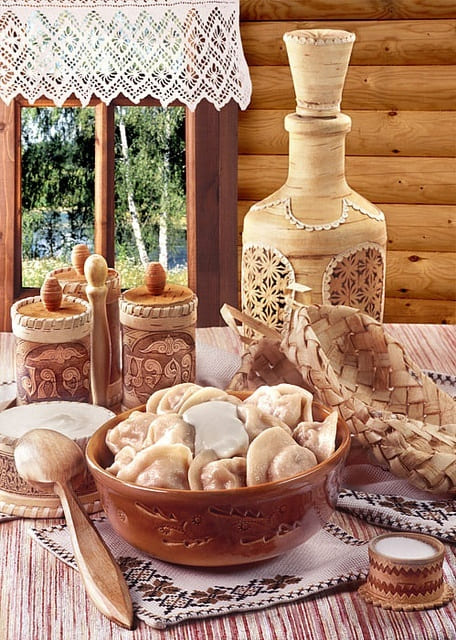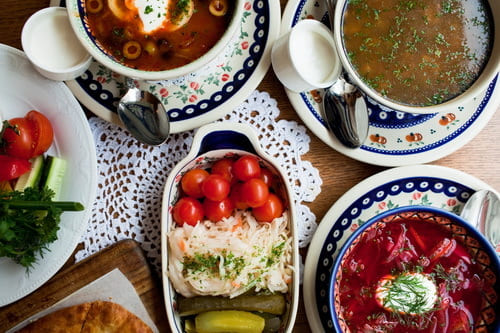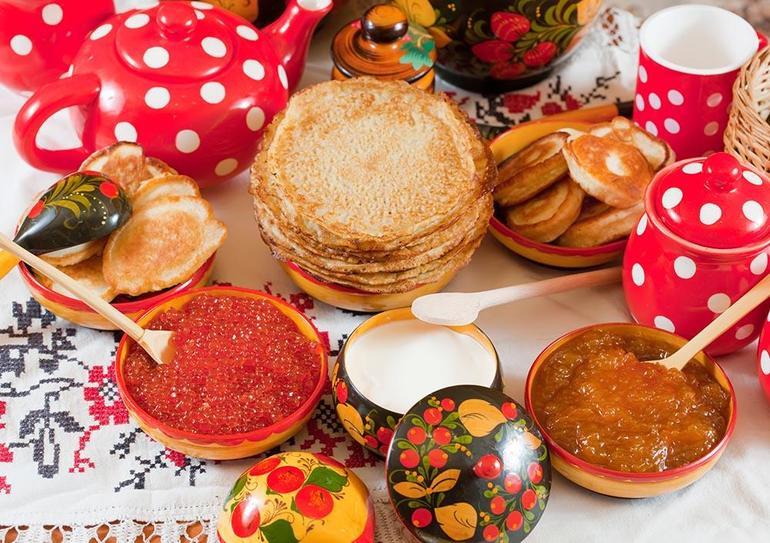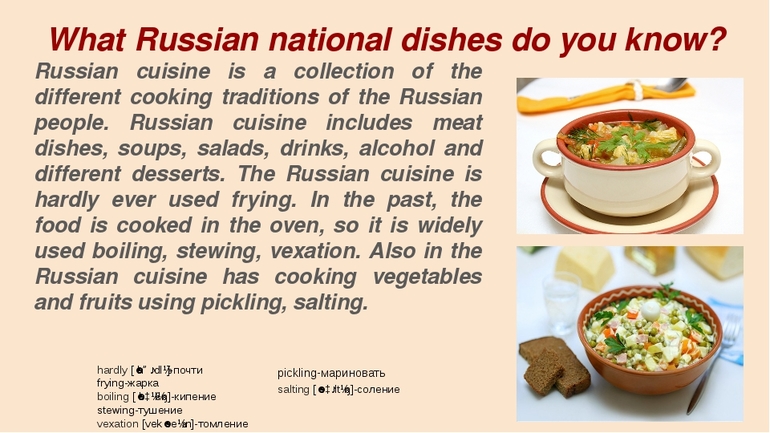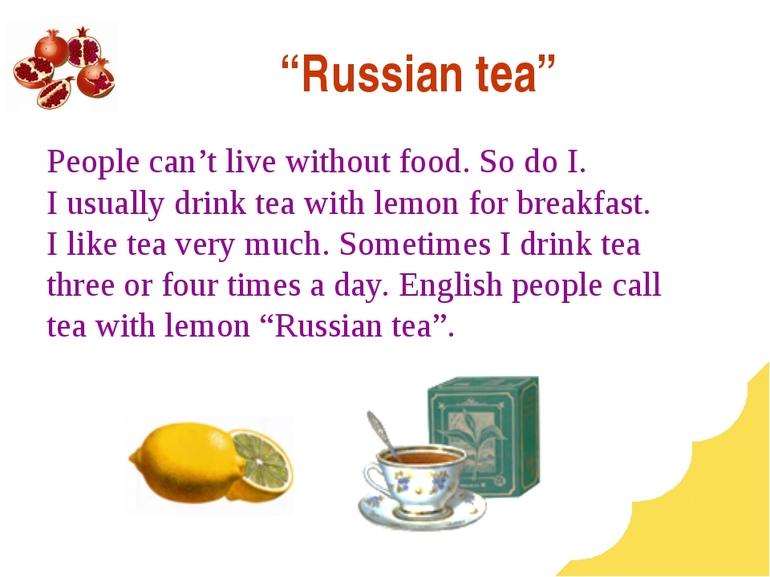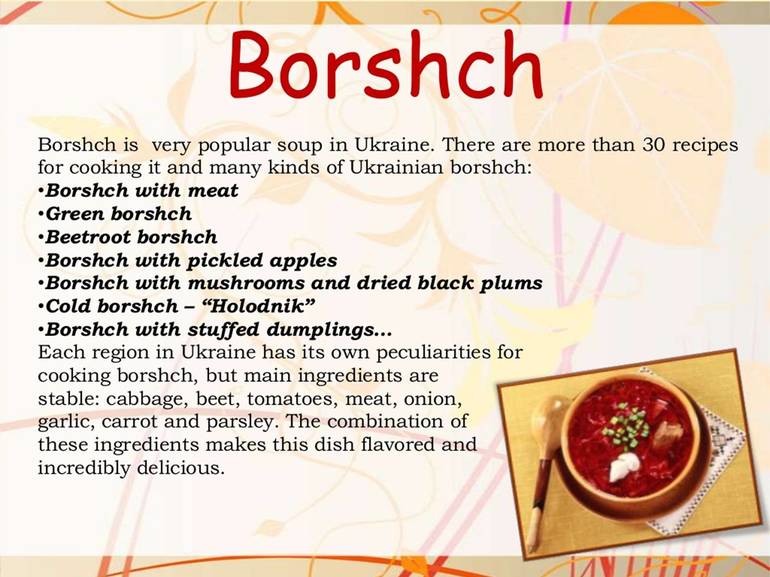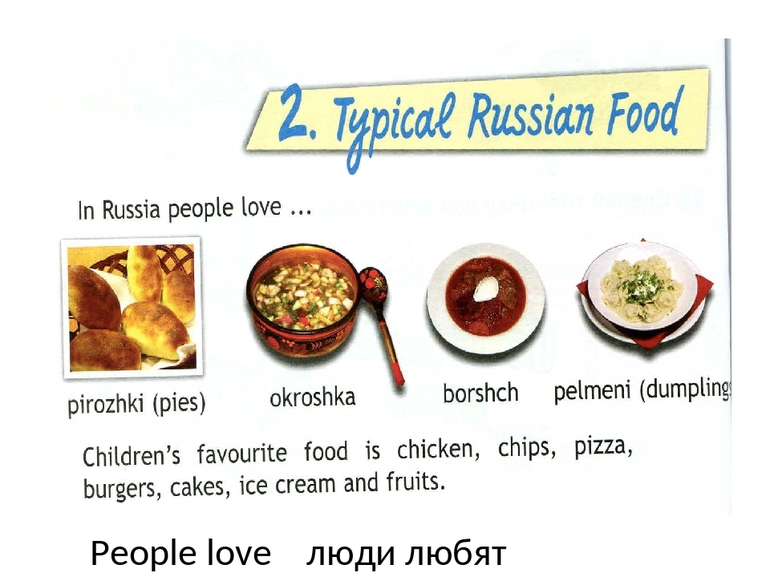Дорогой ученик! В этом материале опубликованы русские блюда на английском языке. Под английским текстом есть перевод на русский язык.
Russian Cuisine
Olivier salad |
|
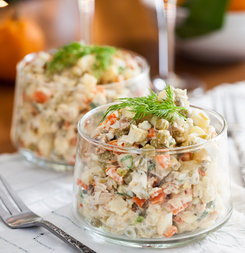 |
Olivier salad is a traditional salad in Russian cuisine, which is also popular in other post-Soviet countries, many European countries, Iran, Israel, Mongolia and also throughout Latin America. In different modern recipes, it is usually made with diced boiled potatoes, carrots, green peas, eggs, diced boiled chicken (or sometimes ham) with salt, pepper, dressed with mayonnaise. |
Okroshka |
|
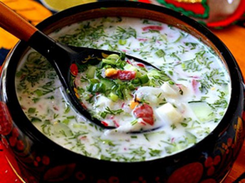 |
Okroshka is a cold soup of Russian origin. The classic soup is a mix of mostly raw vegetables (like cucumbers, radishes and spring onions), boiled potatoes, eggs, and a cooked meat with kvass. Later versions that first appeared in Soviet times use kefir, or mineral water instead of kvass. |
Varenye |
|
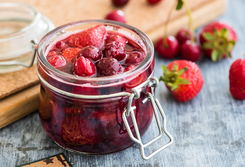 |
Varenye or varenie is a popular dessert, widespread in Eastern Europe (Russia, Ukraine, Belarus). It is made by cooking berries, fruits, or more rarely nuts, vegetables, or flowers, in sugar syrup. |
Blini |
|
 |
Blini are thin, flat cakes prepared from batter and cooked on a hot frying pan – first on one side and then flipped to cook on the other side. Blini are eaten with mushrooms, meat, jam or sour cream. |
Pelmeni |
|
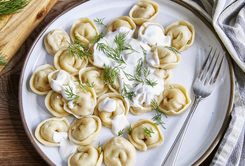 |
Pelmeni are considered as the heart of Russian cuisine. They consist of a filling wrapped in thin dough. The filling can be minced meat or fish. Pelmeni are often served with sour cream (smetana). |
Vinegret |
|
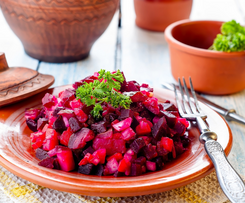 |
Vinegret is a salad in Russian cuisine which is also popular in other post-Soviet states. It includes diced cooked vegetables (beetroots, potatoes, carrots), chopped onions and sauerkraut. Other ingredients, such as green peas or beans, are sometimes also added. |
Блюда русской кухни
Салат Оливье |
|
 |
Салат Оливье – традиционный салат русской кухни, который также популярен в других постсоветских странах, многих странах Европы, Иране, Израиле, Монголии, а также в Латинской Америке. В разных современных рецептах салат Оливье обычно готовят из нарезанного вареного картофеля, моркови, зеленого горошка, яиц, вареной курицы (или иногда ветчины) с солью, перцем, и все это заправляется майонезом. |
Окрошка |
|
 |
Окрошка – это холодный суп русского происхождения. Классическая окрошка готовится в основном из сырых овощей (огурцов, редиса, зеленого лука), вареного картофеля, яиц и вареного мяса с квасом. В более поздних рецептах, которые впервые появились во времена СССР, используется кефир или вода вместо кваса. |
Варенье |
|
 |
Варенье – это популярный десерт, широко распространенный в Восточной Европе (Россия, Украина, Беларусь). Его получают путем варки в сахаре фруктов, ягод или реже орехов, овощей, цветов. |
Блины |
|
 |
Блины – это тонкие, плоские мучные изделия, которые готовят из взбитого жидкого теста и обжаривают на горячей сковороде – сначала на одной стороне, а затем переворачивают на другую. Блины едят с грибами, мясом, вареньем или сметаной. |
Пельмени |
|
 |
Пельмени считаются сердцем русской кухни. Они состоят из начинки, обернутой в тонкое тесто. В качестве начинки может быть мясной фарш или рыба. Пельмени часто подают со сметаной. |
Винегрет |
|
 |
Винегрет – это салат русской кухни, который также популярен и в других постсоветских странах. Его готовят из нарезанных вареных овощей (свеклы, картофеля, моркови), нарезанного лука и квашеной капусты. Также могут быть добавлены и другие ингредиенты, например, зеленый горошек или фасоль. |
Представлено сочинение на английском языке Кухни народов мира/ Cuisines Of The World с переводом на русский язык.
| Cuisines Of The World | Кухни народов мира |
| Every nation living on Earth has its own history, traditions and, of course, features of the national cuisine. A cuisine is a certain set of cooking traditions passed on from generation to generation. A cuisine is often named after the place where it originated. The choice of ingredients depends on the region or country. | Каждый народ, проживающий на Земле, имеет свою историю, традиции и, конечно же, особенности национальной кухни. Кухня представляет собой определенный набор традиций приготовления пищи, передаваемый из поколения в поколение. Кухня часто бывает названа в честь местности, где она возникла. Выбор ингредиентов зависит от региона или страны. |
| For example, the Greeks use lots of tomatoes, olives, lemons and seafood in their dishes because these products are easily found in their country. | Например, греки используют много помидоров, маслин, лимонов и морепродуктов в своих блюдах, потому что эти продукты легко найти в их стране. |
| Today, if you want to taste the food of different countries, it’s not necessary to fly there. The restaurants of various cuisines can be found almost in every city. I live in Yekaterinburg and there are lots of Chinese, Japanese, French, Greek, Italian, Spanish and even Mexican restaurants here. | Сегодня, если вы хотите попробовать еду разных стран, нет необходимости лететь туда. Рестораны различных кухонь можно найти почти в каждом городе. Я живу в Екатеринбурге и здесь есть много китайских, японских, французских, греческих, итальянских, испанских и даже мексиканских ресторанов. |
| Chinese dishes are mostly made of rice and noodles. The thing that I like about this cuisine is the variety of green and herbal teas. | Китайские блюда в основном из риса и лапши. Вот, что мне нравится в этой кухни, так это разнообразие зеленого и травяного чая. |
| Japanese cuisine is based on fresh seafood, soybeans and white rice. I have already tried several types of rolls and sushi with soy sauce and it was rather delicious. | Блюда японской кухни приготовлены из свежих морепродуктов, сои и белого риса. Я уже пробовал несколько типов роллов и суши с соевым соусом, и это было довольно вкусно. |
| French cuisine is considered to be the most exquisite and refined of all. I have never tried French dishes but I’d love to. They say French cheese, wine and pastries are really good. | Французская кухня считается самой изысканной и утонченной из всех. Я никогда не пробовала блюда французской кухни, но с удовольствием попробовала бы. Говорят, французские сыры, вино и пирожные действительно хороши. |
| Greek food is delicious. My favourite dish is the Greek salad with fresh tomatoes, olives, bell peppers and tofu cheese. | Греческая еда вкусная. Мое любимое блюдо – это Греческий салат со свежими помидорами, оливками, болгарским перцем и сыром тофу. |
| I also like Italian food. It mainly offers different types of pizzas and pasta. I think, that Italian cuisine somehow reminds the Greek one because both these countries are situated in the Mediterranean. | Мне также нравится итальянская еда. В неё в основном входят различные виды пиццы и пасты. Я думаю, что итальянская кухня чем-то напоминает греческую, потому что обе эти страны расположены в Средиземноморье. |
| Spanish cuisine offers lots of dishes from seafood and fresh vegetables. A good example of this cuisine is paella. | Испанская кухня предлагает множество блюд из морепродуктов и свежих овощей. Хорошим примером этой кухни является паэлья. |
| Mexican cuisine uses lots of spices and chili pepper. Famous Mexican dishes are tacos and quesadillas. | Мексиканская кухня использует много специй и перца чили. Известные мексиканские блюда – это тако и кесадильи. |
Russia is a huge country and that is why Russian cuisine is a rich collection of diverse cooking traditions. Russian food has its own peculiarities due to the country’s severe climate in winter and its forests rich in berries, mushrooms in summer. Traditional Russian dishes are often made of vegetables, different crops, dairy products, fresh-water fish, poultry and meat.
For breakfast Russian people usually have milk porridge, syrniki (cottage cheese pancakes) or an omelette. Lunch is more sufficient and it often consists of a salad, a plate of soup and a main course. For dinner the Russians love fish and meat dishes with garnish (rice, buckwheat, mashed potatoes and stewed cabbage). Traditional pelmeni (meat dumplings), holodetz (meat jelly with pieces of meat, carrot and garlic) or golubtsy (cabbage rolls with minced meat) are special masterpieces of the national culinary art. The Russians also have salads, meat pies, apple pies, vareniki (cottage cheese, cherries or potatoes dumplings) and pancakes for dinner.
The most traditional Russian salads are Olivier, “Herring under a furcoat” and vinegret. All of them are a nourishing mixture of various ingredients such as boiled eggs, boiled vegetables (potatoes, carrots, beetroot), sausage or meat, onions, green peas and cucumbers.
Russian cuisine is famous for the variety of soups: shchi (cabbage soup), borsch (red beetroot soup), ukha (fish soup), solyanka (thick soup made of pickled veggies, meat and sausage) and rassolnik (pickle soup). A plate of hot and spicy soup helps to stay warm during long cold winters. And one of the favourite soups during hot summers is okroshka (cold vegetable and sausage soup based on kvas). All kinds of soups are normally dressed with sour-cream. It is notable that Russian people eat bread with all dishes.
Traditional Russian drinks are hot black tea with jam or honey, compote (stewed fruit drink) and kvas (drink made from rye bread).
The Russians are good at preserving fruits, vegetables and mushrooms. Classic Russian appetizers: pickled cabbage, tomatoes, crispy cucumbers and even apples – are always on a festive table.
Russian people have always been known for their hospitality. They are happy to welcome guests with lavish dinners with abundance of food on the table.
Перевод
Россия – огромная страна, и поэтому русская кухня представляет собой богатую коллекцию разнообразных кулинарных традиций. Русская еда имеет ряд особенностей благодаря жесткому климату страны зимой и его лесам, богатым ягодами и грибами в летнее время. Традиционные русские блюда часто готовят из овощей, различных круп, молочных продуктов, речной рыбы, дичи и мяса.
На завтрак русский народ обычно ест молочную кашу, сырники (оладьи из творога) или омлет. Обед более сытный и нередко состоит из салата, тарелки супа и основного блюда. На ужин русские любят рыбные и мясные блюда с гарниром (рисом, гречкой, картофельным пюре и тушеной капустой). Традиционные пельмени (клецки с мясом), холодец (мясное желе с кусочками мяса, моркови и чеснока) или голубцы (капустные рулеты с мясным фаршем) являются особенными шедеврами национального кулинарного искусства. Русские также едят салаты, пироги с мясом или яблоками, вареники (клецки с творогом, вишней или картофелем) и блины на ужин.
Наиболее традиционными русскими салатами являются Оливье, Сельдь под шубой и винегрет. Все они представляют собой питательную смесь из различных ингредиентов, таких как вареные яйца, отварные овощи (картофель, морковь, свекла), колбаса или мясо, лук, зеленый горошек и огурцы.
Русская кухня известна разнообразием супов: щи (суп с капустой), борщ (красный суп со свеклой), уха (суп с рыбой), солянка (густой суп из маринованных овощей, мяса и колбасных изделий) и рассольник (суп с соленьями). Тарелка горячего пряного супа помогает оставаться в тепле в долгие холодные зимы. А одним из любимых супов в жаркое лето стала окрошка (холодный суп с овощами и колбасой, приготовленный на квасе). Все виды супов обычно заправляются сметаной. Интересно заметить, что русский народ ест хлеб со всеми блюдами.
Традиционными русскими напитками являются горячий черный чай с вареньем или медом, компот (напиток из тушеных фруктов) и квас (напиток, изготовленный из ржаного хлеба).
Русские прекрасно занимаются консервированием фруктов, овощей и грибов. Классические русские закуски: квашеная капуста, маринованные помидоры, хрустящие огурцы и даже яблоки – всегда лежат на праздничном столе.
Русские люди всегда славились своим гостеприимством. Они рады встречать гостей щедрым ужином с изобилием еды на столе.
Тема «Русская кухня» (Russian cuisine) — 4.6 out of
5
based on
54 votes
План рассказа на английском «Блюда русской кухни»
Любое эссе начинается с вводных слов о предложенной теме. Далее следует раскрыть предмет обсуждения и подвести итоги. План сочинения выглядит так:
- Введение.
- Основная часть.
- Итог.
А также перед написанием можно составить перечень кушаний, которые следует описать. Это могут быть:
- варенье;
- щи;
- борщ;
- пироги;
- кулебяка;
- пельмени;
- вареники;
- оливье;
- говяжий язык и другие.
Эссе на тему «Русская еда»
Во время разработки вариантов экзаменов педагогический коллектив составителей выбирает распространённые темы для письма (последнего задания на ЕГЭ по английскому языку).
Тема еды встречается в довольно простых вариантах. Ниже представлены 3 топика с переводом «Русская еда» для сочинения на английском языке.
Everyday food in Russia
В этом топике описываются повседневные блюда и основные приёмы пищи.
|
Russians, as you know, like to eat delicious food. It may not always be the right and healthy food, but it is very diverse and unusual for foreigners. Mostly in Russia, women cook and pass their favorite recipes to their daughters by inheritance. Most Russians eat three meals a day-Breakfast, lunch, and dinner. Of course, everyone has their own tastes. Usually, the dishes alternate and are chosen according to the mood. For Breakfast, Russians choose fast food, but do not confuse it with American fast food. It usually includes either sandwiches with a drink (tea or coffee), or an omelet, or porridge. For a traditional lunch, 3 dishes are prepared. First course — soup (borsch, Solyanka soup or grub). The second — meat or fish and garnish (rice, potatoes, pasta or buckwheat). The third — compote or juice. Usually Russians have dinner at home, but sometimes in cafes. There are no specific dishes, everyone chooses what they like — vegetables, cereals, pizza, yogurt or cottage cheese. I can talk about Russian food endlessly. Not everyone likes it, but every kitchen has its own connoisseurs. |
Русские, как известно, любят вкусно покушать. Пусть это не всегда правильная и полезная пища, но очень разнообразная и необычная для иностранцев. В основном в России готовят женщины и передают излюбленные рецепты дочерям по наследству. Большинство русских едят три раза в день — завтракают, обедают и ужинают. Конечно, у каждого свои вкусы. Обычно блюда чередуются и выбираются по настроению. На завтрак русские делают блюда быстрого приготовления, но не стоит путать с американским фаст-фудом. Он включает или бутерброды с напитком (чаем или кофе), или омлет, или же кашу. На традиционный обед готовятся 3 блюда. Первое — суп (борщ, щи, солянка или харчо). Второе — мясо или рыба и гарнир (рис, картофель, макароны или гречка). Третье — компот или морс. Обычно русские ужинают дома, но иногда в кафе. Здесь нет определённых блюд, каждый выбирает то, что ему по вкусу — овощи, хлопья, пицца, йогурт или творог. О русской еде можно говорить бесконечно. Не всем она по нраву, но у каждой кухни находятся свои ценители. |
Russian traditional dishes
В каждой стране есть свои классические рецепты, которые формируются под воздействием географического положения, климата, менталитета и обычаев народа.
В сочинении на английском языке «Традиционные блюда России» содержится описание устоявшихся русских кушаний, от которых иностранцы приходят в шок.
|
The main feature of Russian cuisine can be considered originality and uniqueness. Tourists are often perplexed when trying our dishes. What kind of food so frighten visitors? Wobbler ranks first in the rating of the most terrible dishes in the understanding of the British and Americans. They do not recognize other parts of the animal’s body other than meat. Also, in their understanding, jelly is a dessert, not a second course, and certainly not an appetizer. Borscht is a dish that almost all foreigners like. In the soup, which is based on beets, add a large amount of meat and stewed vegetables. Pancakes are a native Russian dish. These are flatbreads made on the basis of milk and flour. They can be either salted (meat, cheese or caviar) or sweet (jam or syrup). In English — speaking countries, there is a similar dish-pancake. Caviar on the contrary is very popular with tourists from other countries. This is a salty dish that is served on a piece of bread with butter. Russia is rich in sauerkraut, meat and fish dishes that are worth trying at least once in your life. |
Главной особенностью русской кухни можно считать самобытность и неповторимость. Туристы часто недоумевают, пробуя наши блюда. Какие же кушанья так пугают приезжих? Холодец занимает первое место в рейтинге самых ужасных блюд в понимании англичан и американцев. Они не признают другие части тела животного, кроме мяса. Также в их понимании желе — это десерт, а не второе блюдо, и уж тем более не закуска. Борщ — это блюдо, которое нравится почти всем иностранцам. В суп, в основе которого свёкла, добавляют большое количество мяса и тушёных овощей. Блины — исконно русское кушанье. Это такие лепёшки, сделанные на основе молока и муки. Они могут быть как с солёной начинкой (мясо, сыр или икра), так и со сладкой (варенье или сироп). В англоязычных странах есть похожее блюдо — панкейки. Икра, наоборот, очень нравится туристам из других стран. Это солёное блюдо, которое подаётся на кусочке хлеба с маслом. Россия богата квашеными, мясными и рыбными блюдами, которые хоть раз в жизни точно стоит попробовать. |
Russian cuisine
Русская кухня — это очень ёмкое и широкое понятие. Она включает в себя всевозможные соленья, квашенья, супы, каши и различную выпечку.
В тексте на английском языке по теме «Блюда русской кухни» упоминаются самые популярные яства России.
| Russia is a great country. Every year its attractions attract tourists. Russian national cuisine at the same time fascinates and terrifies visitors. One of the famous dishes of Russian cuisine is Olivier salad. It includes boiled potatoes, sausage, eggs, green peas and mayonnaise. This dish is also popular in Iran, Israel, Mongolia and Latin America. Okroshka is a cold soup that Russians fill with kefir or kvass. Cooking it is very easy, because all the products match the ingredients of Olivier (except mayonnaise) and there is in the refrigerator of every person. Pelmeni are considered the heart of Russian cuisine. They are to the taste of almost everyone. Dumplings are similar to manti, but are cooked in boiling water. These are small pies made of dough with meat filling. If you change the filling to berry or cottage cheese, you will get another Russian dish called vareniki. If you are going to travel to Russia, you should definitely try dishes, described in this topic. | Россия — великая страна. С каждым годом её достопримечательности привлекают туристов. Русская национальная кухня одновременно восхищает и ужасает приезжих. Одним из известных блюд русской кухни является салат оливье. В его состав входит варёный картофель, колбаса, яйца, зелёный горошек и майонез. Это блюдо также популярно в Иране, Израиле, Монголии и Латинской Америке. Окрошка — это холодный суп, который русские заправляют кефиром или квасом. Приготовить ее очень легко, ведь все продукты совпадают с ингредиентами оливье (кроме майонеза) и есть в холодильнике почти каждого человека. Пельмени считаются сердцем русской кухни. Они по вкусу почти всем. Пельмени похожи на манты, но готовятся в кипящей воде. Это такие маленькие пирожочки из теста с начинкой из мяса. Если поменять начинку на ягодную или творожную, то получится другое русское блюдо под названием вареники. Если вы собираетесь поехать в Россию, то обязательно попробуйте блюда, описанные в этом сочинении. |
В мире насчитывается более семи тысяч языков. Самый популярный из них — английский. Несмотря на красоту и любовь к русскому язык, филологи утверждают, что самым богатым языком является именно английский. Основные знания этого языка крайне необходимы представителям многих профессий, так как более половины справочных материалов, книг и трудов великих учёных написаны на английском.
метки: Around, Блюдо, Русская, Перевод, Russian, Россия, Include, Traditional
- Основная часть.
- Итог.
А также перед написанием можно составить перечень кушаний, которые следует описать. Это могут быть:
- варенье;
- щи;
- борщ;
- пироги;
- кулебяка;
- пельмени;
- вареники;
- оливье;
- говяжий язык и другие.
Эссе на тему «Русская еда»
Во время разработки вариантов экзаменов педагогический коллектив составителей выбирает распространённые темы для письма (последнего задания на ЕГЭ по английскому языку).
Тема еды встречается в довольно простых вариантах. Ниже представлены 3 топика с переводом «Русская еда» для сочинения на английском языке.
Everyday food in Russia
В этом топике описываются повседневные блюда и основные приёмы пищи .
|
Russians, as you know, like to eat delicious food. It may not always be the right and healthy food, but it is very diverse and unusual for foreigners. Mostly in Russia, women cook and pass their favorite recipes to their daughters by inheritance. Most Russians eat three meals a day-Breakfast, lunch, and dinner. Of course, everyone has their own tastes. Usually, the dishes alternate and are chosen according to the mood. For Breakfast, Russians choose fast food, but do not confuse it with American fast food. It usually includes either sandwiches with a drink (tea or coffee), or an omelet, or porridge. For a traditional lunch, 3 dishes are prepared. First course — soup (borsch, Solyanka soup or grub).
The second — meat or fish and garnish (rice, potatoes, pasta or buckwheat). The third — compote or juice. Usually Russians have dinner at home, but sometimes in cafes. There are no specific dishes, everyone chooses what they like — vegetables, cereals, pizza, yogurt or cottage cheese. I can talk about Russian food endlessly. Not everyone likes it, but every kitchen has its own connoisseurs. |
Русские, как известно, любят вкусно покушать. Пусть это не всегда правильная и полезная пища, но очень разнообразная и необычная для иностранцев. В основном в России готовят женщины и передают излюбленные рецепты дочерям по наследству. Большинство русских едят три раза в день — завтракают, обедают и ужинают. Конечно, у каждого свои вкусы. Обычно блюда чередуются и выбираются по настроению. На завтрак русские делают блюда быстрого приготовления, но не стоит путать с американским фаст-фудом. Он включает или бутерброды с напитком (чаем или кофе), или омлет, или же кашу. На традиционный обед готовятся 3 блюда. Первое — суп (борщ, щи, солянка или харчо).
Второе — мясо или рыба и гарнир (рис, картофель, макароны или гречка). Третье — компот или морс. Обычно русские ужинают дома, но иногда в кафе. Здесь нет определённых блюд, каждый выбирает то, что ему по вкусу — овощи, хлопья, пицца, йогурт или творог. О русской еде можно говорить бесконечно. Не всем она по нраву, но у каждой кухни находятся свои ценители. |
Russian traditional dishes
В каждой стране есть свои классические рецепты, которые формируются под воздействием географического положения, климата, менталитета и обычаев народа.
В сочинении на английском языке «Традиционные блюда России» содержится описание устоявшихся русских кушаний, от которых иностранцы приходят в шок.
|
The main feature of Russian cuisine can be considered originality and uniqueness. Tourists are often perplexed when trying our dishes. What kind of food so frighten visitors? Wobbler ranks first in the rating of the most terrible dishes in the understanding of the British and Americans. They do not recognize other parts of the animal’s body other than meat. Also, in their understanding, jelly is a dessert, not a second course, and certainly not an appetizer. Borscht is a dish that almost all foreigners like. In the soup, which is based on beets, add a large amount of meat and stewed vegetables. Pancakes are a native Russian dish. These are flatbreads made on the basis of milk and flour. They can be either salted (meat, cheese or caviar) or sweet (jam or syrup).
In English — speaking countries, there is a similar dish-pancake. Caviar on the contrary is very popular with tourists from other countries. This is a salty dish that is served on a piece of bread with butter. Russia is rich in sauerkraut, meat and fish dishes that are worth trying at least once in your life. |
Главной особенностью русской кухни можно считать самобытность и неповторимость. Туристы часто недоумевают, пробуя наши блюда. Какие же кушанья так пугают приезжих? Холодец занимает первое место в рейтинге самых ужасных блюд в понимании англичан и американцев. Они не признают другие части тела животного, кроме мяса. Также в их понимании желе — это десерт, а не второе блюдо, и уж тем более не закуска. Борщ — это блюдо, которое нравится почти всем иностранцам. В суп, в основе которого свёкла, добавляют большое количество мяса и тушёных овощей. Блины — исконно русское кушанье. Это такие лепёшки, сделанные на основе молока и муки. Они могут быть как с солёной начинкой (мясо, сыр или икра), так и со сладкой (варенье или сироп).
В англоязычных странах есть похожее блюдо — панкейки. Икра, наоборот, очень нравится туристам из других стран. Это солёное блюдо, которое подаётся на кусочке хлеба с маслом. Россия богата квашеными, мясными и рыбными блюдами, которые хоть раз в жизни точно стоит попробовать. |
Russian cuisine
Русская кухня — это очень ёмкое и широкое понятие. О на включает в себя всевозможные соленья, квашенья, супы, каши и различную выпечку.
В тексте на английском языке по теме «Блюда русской кухни» упоминаются самые популярные яства России .
| Russia is a great country. Every year its attractions attract tourists. Russian national cuisine at the same time fascinates and terrifies visitors. One of the famous dishes of Russian cuisine is Olivier salad. It includes boiled potatoes, sausage, eggs, green peas and mayonnaise. This dish is also popular in Iran, Israel, Mongolia and Latin America. Okroshka is a cold soup that Russians fill with kefir or kvass. Cooking it is very easy, because all the products match the ingredients of Olivier (except mayonnaise) and there is in the refrigerator of every person. Pelmeni are considered the heart of Russian cuisine. They are to the taste of almost everyone. Dumplings are similar to manti, but are cooked in boiling water. These are small pies made of dough with meat filling. If you change the filling to berry or cottage cheese, you will get another Russian dish called vareniki. If you are going to travel to Russia, you should definitely try dishes, described in this topic. | Россия — великая страна. С каждым годом её достопримечательности привлекают туристов. Русская национальная кухня одновременно восхищает и ужасает приезжих.
Одним из известных блюд русской кухни является салат оливье. В его состав входит варёный картофель, колбаса, яйца, зелёный горошек и майонез. Это блюдо также популярно в Иране, Израиле, Монголии и Латинской Америке. Окрошка — это холодный суп, который русские заправляют кефиром или квасом. Приготовить ее очень легко, ведь все продукты совпадают с ингредиентами оливье (кроме майонеза) и есть в холодильнике почти каждого человека. Пельмени считаются сердцем русской кухни. Они по вкусу почти всем. Пельмени похожи на манты, но готовятся в кипящей воде. Это такие маленькие пирожочки из теста с начинкой из мяса. Если поменять начинку на ягодную или творожную, то получится другое русское блюдо под названием вареники. Если вы собираетесь поехать в Россию, то обязательно попробуйте блюда, описанные в этом сочинении. |
В мире насчитывается более семи тысяч языков. Самый популярный из них — английский. Несмотря на красоту и любовь к русскому язык, филологи утверждают, что самым богатым языком является именно английский. Основные знания этого языка крайне необходимы представителям многих профессий, так как более половины справочных материалов, книг и трудов великих учёных написаны на английском.
Traditional British Cuisine – Топик Традиционная Британская Кухня
As a rule, traditional food shows an attitude of the whole nation to nutrition. British people are conservative as well as their cuisine. Food is plain, nutritious and monotonous. However, don’t think it is not delicious, there are dishes popular all over the world. Such foods are tasty, fatty a bit and able to give you energy for the whole day. Let’s have a look at the specialties related to England
There are four meals during the day – breakfast, lunch, dinner and supper. Apart from, there can be snacks between the meals and 5 o’clock tea. This is not a typical cup of with a piece of cake, that is a real ceremony with sandwiches, buns and even alcohol. So, I’m going to give you one traditional dish for every meal.
Breakfast
Classic British breakfast tends to be rather substantial. You may limit it with porridge and you will be only half-right. Cereals are popular while having a breakfast but many prefer the Full English instead. It includes eggs, fried pork or bacon which are often replaced with kidneys, fried bread, a sausage or a black pudding, potatoes, vegetables and beans. And all the ingredients are on one plate eaten for breakfast.
Lunch
Lunch may seem lighter than breakfast. It consists of sandwiches, fruit, cookies or chocolate bars. Sandwiches are traditional English dish, they can be with different stuff like bacon, cheese, tuna, cucumber and so on. Fish and chips is also a traditional dish. Fish sticks and French fries are often served with a slice of lemon and green and tomato sauce or ketchup.
Dinner
Dinner is the largest meal of the day. People usually have dinner after work from 4 to 6 p.m. As you could guess, dinner is almost relevant to supper despite the fact that it related to lunch first. For dinner the British prefer meat, poultry or fish served with vegetables or mashed potatoes. Then, a dessert goes. It is represented by a cake or a pie. A good example of dinner is Yorkshire pudding. Don’t confuse a pudding with a dessert. Yorkshire pudding’s ingredients are eggs, flour, milk and fat. It is served with roast beef and meet dressing.
Supper
Supper is the last meal in Britain. People eat something light like cream soup, a cup of tea with a sandwich or bread and butter. And here there is need to say that the Brits like jam. They like jam so much that invented a dish called scones. As history claims, there were two idiots who couldn’t agree what to put on the cone first – the jam or the cream? So, scones are buns with creams and jams.
Как правило, традиционные блюда демонстрируют отношение всей нации к питанию. Британцы консервативны так же, как и их кухня. Еда простая, питательная и однообразная. Однако, не думайте, что она не вкусная, есть блюда, популярные во всем мире. Такая еда вкусная, немного жирная и способная дать вам энергию на весь день. Давайте посмотрим на коронные блюда, связанные с Англией.
Есть четыре приема пищи в течение дня — завтрак, обед, ужин и ужин. Кроме того, между приемами пищи и чаем в 5 часов могут быть закуски. Пятичасовый чай — это не обычная чашка чая с куском пирога, это настоящая церемония с бутербродами, булочками и даже алкоголем. Так что, давайте разберем одно традиционное блюдо на каждый прием пищи.
Завтрак.
Классический британский завтрак имеет тенденцию быть довольно существенным. Вы можете ограничиться только кашей и будете только наполовину правы. Во время завтрака популярны злаки, но многие предпочитают полный английский завтрак. Он состоит из яиц, жареной свинины или бекона, который часто заменяются почками, есть жареный хлеб, колбаса или кровянка, картофель, овощи и бобы. И все ингредиенты на одной тарелке едят на завтрак.
Обед.
Обед может показаться легче, чем завтрак. Он состоит из бутербродов, фруктов, печенья или шоколадных батончиков. Бутерброды являются традиционным английским блюдом, они могут быть с различной начинкой, такой как бекон, сыр, тунец, огурец и так далее. Рыба с жареным картофелем также является традиционным блюдом. Рыбные палочки и картофель фри часто подают с ломтиком лимона и зелени и томатным соусом или кетчупом.
Первый ужин.
Ужин – самый большой прием пищи за день. Люди обычно обедают после работы с 4 до 6 часов вечера. Как вы могли догадаться, ужин “dinner” тоже самое что “supper”, хотя раньше этим словом обозначали обед. На ужин британцы предпочитают мясо, птицу или рыбу с овощами или картофельным пюре. Затем идет десерт. Это торт или пирог. Хорошим примером обеда является йоркширский пудинг. Не путайте пудинг с десертом. В состав йоркширского пудинга входят яйца, мука, молоко и жир. Подается с ростбифом и соусом.
Ужин.
Ужин — последний прием пищи в Британии. Люди едят что-то легкое, например, крем-суп, чашку чая с бутербродом или хлеб с маслом. И тут нужно сказать, что британцы любят варенье. Они так любят варенье, что изобрели блюдо под названием «scones”. Как гласит история, было два идиота, которые не могли договориться о том, что сначала положить на булку — джем или крем? Так что, «scones” — это булочки с кремом и джемом.
►Russian Culture ►Russian Cuisine
Russian cuisine often gets a bad press for being bland and stodgy but this reputation is undeserved. Russian cuisine has some delicious dishes which you should definitely try when visiting the country. Russian cuisine has absorbed European, eastern, southern and northern influences and it can vary from region to region, even in respect of the same dish. Russian food tends to be very heavy with lots of fat due to the use of oil, butter, sour cream and mayonnaise. This can be explained by the traditional need of calories during Russia’s harsh winters. Pickled foods also feature heavily, again due to the winter and the need to preserve fresh products. Traditionally Russian food was cooked in special ovens which even today are still found all over Russian villages. Below we provide you with a brief guide of some of the dishes you will see on a traditional Russian menu.
Zakuski / Hors d’oeuvre (Закуски)
A special feature of Russian cuisine is its wide array of hors d’oeuvre. These can be made out of vegetables, meat or fish and can be ordered as a started or just to have on the table throughout the dinner, as they are often eaten after a shot of vodka is drunk.
Caviar (Икра)
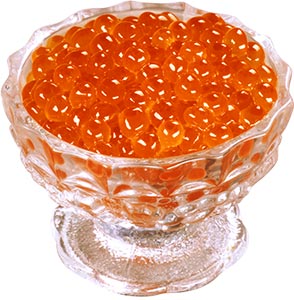
Kholodets (Холодец)
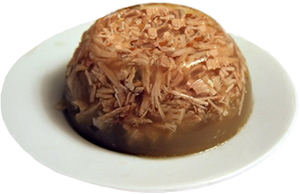
Pies (Пирожки)
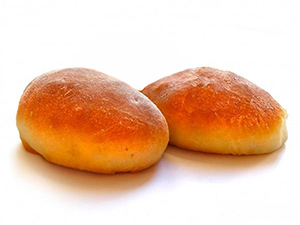
Julienne (Жюльен)

Salads (Салаты)
Russians tend to prefer their salads heavy with lots of mayonnaise, although European style olive oil and vinegar-based salads, such as caesar salads and greek salads, can now be found alongside the tradition Russian salads on most menus across the country. Russian salads with fresh vegetables often use sunflower oil rather than olive oil.
Olivier (Оливье)
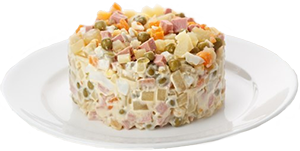
Vinegret (Винегрет)
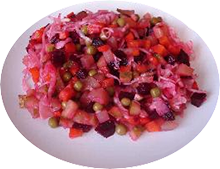
Herring In a Fur Coat (Селёдка под шубой)
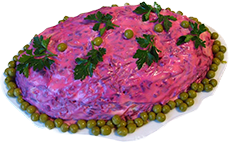
Korean Carrots (Морковь по-корейски)
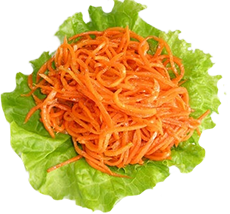
Breakfast Dishes (Завтраки)
Russian breakfasts at restaurants and hotels can vary and sometimes dishes more resembling dinner such as sausages and pasta can be served. The dishes mentioned below though make a delicious start to the day.
Kasha (Каша)
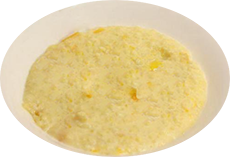
Blini (Блины)

Syrniki (Сырники)
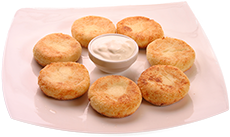
Oladi (Оладьи)

Soups (Супы)
Soup is an important dish in Russia and most Russian meals start with soup. In fact the common type of service where various courses (salad, soup, main, desert) are brought sequentially was originally known as Service à la russe (‘service in the Russian style) and previously in Europe all dishes were placed on the table at once.
Borsch (Борщ)
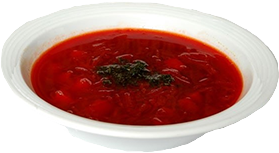
Schi (Щи)
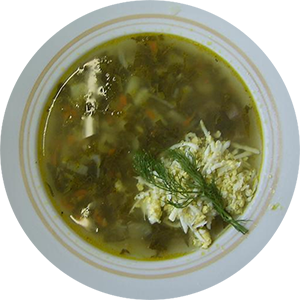
Ukha (Уха)
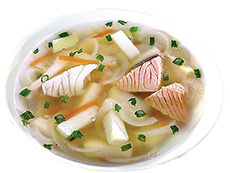
Okroshka (Окрошка)
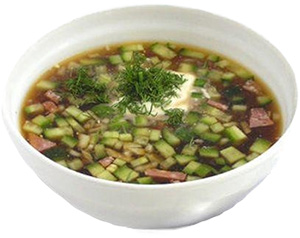
Solyanka (Солянка)
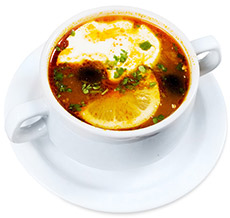
Rassolnik (Рассольник)

Main courses (Основные блюда)
Most Russian main courses consist of meat and although the situation is improving, vegetarians still don’t always have a lot of choice when order food in restaurants. The most popular meats in Russia are pork, beef, chicken and lamb. However you can also sometimes find on the menu rabbit, duck, goose and in some specialist restaurants even wild boar, moose, venison and bear. In restaurants you normally need to choose a side dish separately to your main. Popular side dishes include fried potato, mashed potatoes, chips, rice, buckwheat or macaroni. Upon arriving in Russia it won’t take long for you to notice that dill is a popular herb in Russian cuisine.
Shashlyk (Шашлык)
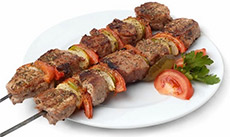
Cutlets (Котлеты)

Escalopes (Эскалопы)
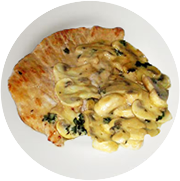
Beef Stroganov (Бефстроганов)
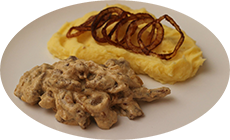
Zharkoe (Жаркое)
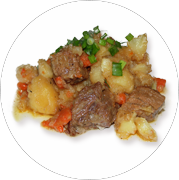
Pelmeni (Пельмени)
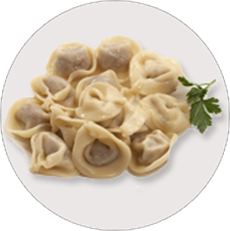
Vareniki (Вареники)
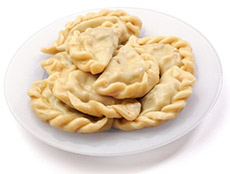
Manty (Манты)

Golubtsy (Голубцы)
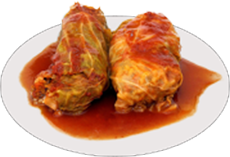
Drinks (Напитки)
Although in Russian you can now get hold of most of the brands of soft drinks and alcohol you find in the West, there are some drinks that are specialities of Russia. The most popular non-alcoholic drink in Russia is probably tea and most gatherings will probably end with a cup of tea accompanied with something sweet.
Vodka (Водка)

Mors (Морс)
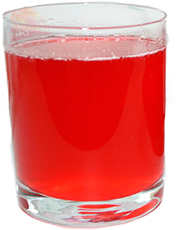
Kompot (Компот)
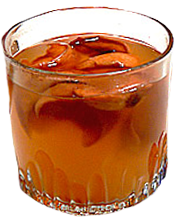
Kvas (Квас)

Medovukha (Медовуха)

Sbiten (Сбитень)
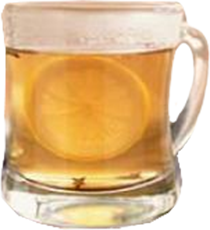
Kefir (Кефир)
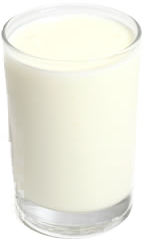
Kisel (Кисель)
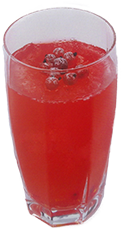
Baikal (Байкал)

►Russian Culture ►Russian Cuisine

